Links
Contact
Prof. Dr. Helge Bruelheide
phone: 0345 55 26222
helge.bruelheide@botanik.un...
Institute for Biology/Chair of Geo-botany
06099 Halle (Saale)
Login for editors
50 Hectors of Diversity
International research team explores Biodiversity in the subtropical forests of China
MELANIE ZIMMERMANN
For Geo-botanist Prof. Dr. Helge Bruelheide, from the Institute for Biology at the Martin-Luther University (MLU), spring began with a challenge: to plant 100,000 new trees in Xingangshan located in the province of Jianxi of subtropical China. In this hotspot of biological diversity, with forests in which hundreds of tree species can be found, one the world’s largest experiments on the role of biodiversity for ecosystem functions is taking place. In this setting, 18 researchers from Germany and Switzerland have recently combined forces with a group of Chinese researchers to plant forests with different complexities and plant species on 50 hectors of land.
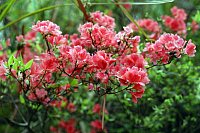
The Indian Azalea (Rhododendron simsii), very popular amongst Europeans as a cultivated house plant, also stems from China. Photo: Helge Bruelheide
The goal of this project, which began in 2008 and is supported by almost three million Euros from the German Research Group (DFG), is “to research the effects of diversity of trees and bushes on the biological functioning and balance of the forest ecosystem” says Helge Bruelheide. As speaker of the DFG Research Group 891 “BEF China”, she explains: “On the one hand the importance lies in basic research to create an understanding of the function of biodiversity, and on the other hand it helps create ways in which biodiversity can be promoted and used.”
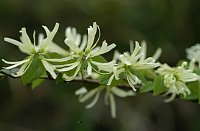
The Loropetalum chinense, a Hamamelis or witch hazel, is at home in the subtropical forests of China. Photo: Helge Bruelheide
The regions of the provinces of Zhejiang and Jiangxi are ideal for the project. No where in the northern hemisphere can such a large diversity of trees and bushes be found. The Gutianshan nature reserve in the province of Zhejiang has five times as many tree species than all of Germany. A main focus of the first phase of the research project lay in comparing the diversity in natural and secondary forests. Not only were all plant types identified, but productivity, carbon storage, nutrient cycles, soil erosion, soil conditions and dependence on animals and fungi were also analyzed.
A variety of questions, like how the productivity of a forest can be influenced through biodiversity, could not be answered by researching natural forests. This is because individual processes cannot be disassociated and observed independently. For this reason the international research team has developed an experiment based on the assumption that the diversity of species is important for the function of an ecosystem. It is based on niche theory: when several species develop and grow under the same circumstances, then it is likely they make better use of the available environmental factors, such as light or ground water.
LOGISTIC CHALLENGES
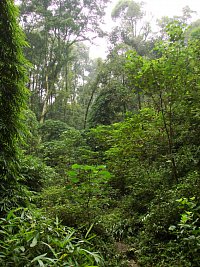
Natural forest (reference site) in China. Photo: Sabine Both
For the experiment a variety of trees and bushes were grown in nurseries. On a huge area of land of about 50 hectors, seedlings from about 100 tree types, so about 50 trees and 50 bushes of each species, as well as 50 evergreens and 50 summer species, were planted by hand in rows and partitions. The experiment follows a design in which plants from different diversity categories, with 1, 2, 4, 8, 16, or 24 types per area, were planted. The entire species inventory was divided into three parts, with 16 tree groups, each with six different sub-species.
About 100,000 trees and bushes were first planted on 25 hectors of land in March and April 2009. Further 100,000 plants will be planted in the coming weeks. Professor Bruelheide explains: “The entire thing is a logistical challenge, because every tree and bush in the experiment was given a predetermined spot. This will allow for the development of each individual plant to be monitored over the coming years and decades”.
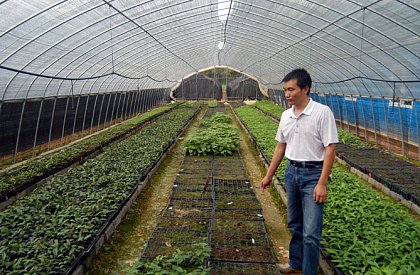
One of five green houses in the Jiangxi province, used to rear 500,000 seedlings for the second phase of the project. Photo: Helge Bruelheide
WORK FOR MANY GENERGATIONS
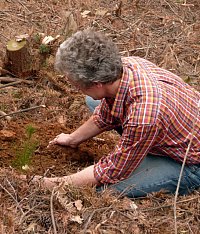
On 19 March 2009, Prof. Dr. Helge Bruelheide planted the first tree for the largest biodiversity experiment worldwide. Photo: Sylvie Herrmann
Parallel to this experiment in China, research and analysis is taking place at the institutes of the various universities partaking in the experiment. For example, geo-botanist Dr. Alexandra Erfmeier and doctoral researcher Sabine Both in Halle are experimenting at the MLU, pursuing the question whether high diversity in local plants in the subtropical forests protect their environment from exotic intruders. In other words, do they protect against strange species, which could displace native plants and could change the functions of the ecosystem.
The scope of this project is far reaching. It brings with it the basis for work for many generations of researchers to come. Although the researchers presume that the impacts of diverse species on the ecosystem processes with already be observable in the early stages of the experiment, the strength of the evaluations with grow exponentially over time. Geo-botanist Bruelheide knows: “It will be the coming generations who will reap what we sow”.
More in the Internet: DFG Science TV presents details about the experiment in video reports: www.dfg-science-tv.de/de/projekte/funktion-durch-vielfalt
